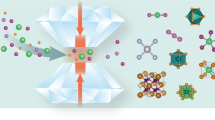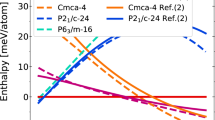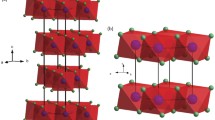Abstract
In this work, high-pressure phase behavior of LiPN2 within 0–300 GPa was studied by using an unbiased structure searching method in combination with first-principles calculations. Three pressureinduced phase transitions were predicted, as tI16 → hR4 → cF64 → oP8 at 44, 136, and 259 GPa, respectively. The six-fold coordination environments were found for all high-pressure polymorphs, which are substantially different from the four-fold coordination environments observed in the tI16 structure. The hR4 and cF64 structures consist of close-packed PN6 and LiN6 octahedra connected by edge-sharing, whereas the oP8 structure is built up from edge- and face-sharing PN6 and LiN6 octahedra with N lying in the center of the trigonal prisms. The electronic structure analysis reveals that LiPN2 is a semiconductor within the pressure range studied and P-N and Li-N bonds are covalent and ionic, respectively. The results obtained are expected to provide insight and guidance for future experiments on LiPN2 and other alkali metal nitridophosphates.
Similar content being viewed by others
References
E. M. Bertschler, R. Niklaus, and W. Schnick, Li12P3N9 with non-condensed [P3N9]12--rings and its highpressure polymorph Li4PN3 with infinite chains of PN- 4 tetrahedra, Chemistry 23(40), 9592 (2017)
A. Al-Qawasmeh and N. A. W. Holzwarth, Li14P2O3N6 and Li7PN4: Computational study of two nitrogen rich crystalline LiPON electrolyte materials, J. Power Sources 364, 410 (2017)
W. Schnick and J. Luecke, Lithium ion conductivity of LiPN2 and Li7PN4, Solid State Ion. 38(3–4), 271 (1990)
E. M. Bertschler, C. Dietrich, J. Janek, and W. Schnick, Li18P6N16 — A lithium nitridophosphate with unprecedented tricyclic [P6N16]18- Ions, Chemistry 23(9), 2185 (2017)
W. Schnick and U. Berger, Li10P4N10 — A lithium phosphorus(V) nitride containing the new complex anion [P4N10]10-, Angew. Chem. Int. Ed. Engl. 30(7), 830 (1991)
R. Marchand, P. L’Haridon, and Y. Laurent, Etude cristallochimique de LiPN2: Une structure derivée de la cristobalite, J. Solid State Chem. 43(2), 126 (1982)
Y. M. Basalaev, Y. N. Zhuravlev, V. S. Permina, and A. S. Poplavnoi, LiPN2 and NaPN2 crystals: Structural features and chemical bonding, J. Struct. Chem. 48(6), 996 (2007)
A. V. Kosobutsky, Lattice dynamics and elastic properties of LiPN2 and NaPN2, J. Phys. Condens. Matter 21(40), 405404 (2009)
D. Baumann and W. Schnick, Pentacoordinate phosphorus in a high-pressure polymorph of phosphorus nitride imide P4N6(NH), Angew. Chem. Int. Ed. 53(52), 14490 (2014)
F. J. Pucher, S. R. Römer, F. W. Karau, and W. Schnick, Phenakite-type BeP2N4 — A possible precursor for a new hard spinel-type material, Chemistry 16(24), 7208 (2010)
Y. Wang, J. Lv, L. Zhu, and Y. Ma, Crystal structure prediction via particle-swarm optimization, Phys. Rev. B 82(9), 094116 (2010)
Y. Wang, J. Lv, L. Zhu, and Y. Ma, CALYPSO: A method for crystal structure prediction, Comput. Phys. Commun. 183(10), 2063 (2012)
Y. Wang and Y. Ma, Perspective: Crystal structure prediction at high pressures, J. Chem. Phys. 140(4), 040901 (2014)
Y. Wang, J. Lv, L. Zhu, S. Lu, K. Yin, Q. Li, H. Wang, L. Zhang, and Y. Ma, Materials discovery via CALYPSO methodology, J. Phys.: Condens. Matter 27(20), 203203 (2015)
H. Wang, Y. Wang, J. Lv, Q. Li, L. Zhang, and Y. Ma, CALYPSO structure prediction method and its wide application, Comput. Mater. Sci. 112 (Part B), 406 (2016)
L. Zhang, Y. Wang, J. Lv, and Y. Ma, Materials discovery at high pressures, Nat. Rev. Mater. 2(4), 17005 (2017)
G. Kresse and J. Furthmüller, Efficient iterative schemes for ab initio total-energy calculations using a plane-wave basis set, Phys. Rev. B 54(16), 11169 (1996)
P. E. Blöchl, Projector augmented-wave method, Phys. Rev. B 50(24), 17953 (1994)
H. J. Monkhorst and J. D. Pack, Special points for Brillouin-zone integrations, Phys. Rev. B 13(12), 5188 (1976)
A. Togo, F. Oba, and I. Tanaka, First-principles calculations of the ferroelastic transition between rutile-type and CaCl2-type SiO2 at high pressures, Phys. Rev. B 78(13), 134106 (2008)
S. Maintz, V. L. Deringer, A. L. Tchougréeff, and R. Dronskowski, LOBSTER: A tool to extract chemical bonding from plane-wave based DFT, J. Comput. Chem. 37(11), 1030 (2016)
K. Momma and F. Izumi, VESTA 3 for threedimensional visualization of crystal, volumetric and morphology data, J. Appl. Cryst. 44(6), 1272 (2011)
D. Xu and B. Li, Exotic high-pressure behavior of double nitride CuPN2 (unpublished)
R. W. G. Wyckoff, Crystal structure of high temperature cristobalite, Am. J. Sci. s5–9(54), 448 (1925)
M. Råsander and M. A. Moram, Electronic structure of the high and low pressure polymorphs of MgSiN2, Mater. Res. Express 3(8), 085902 (2016)
Acknowledgments
The authors acknowledge funding support from the National Natural Science Foundation of China (Grant Nos. 11474128 and 11534003), Science Challenge Project (Grant No. TZ2016001), National Key Research and Development Program of China (Grant Nos. 2016YFB0201200, 2016YFB0201201, and 2016YFB0201204), and Program for JLU Science and Technology Innovative Research Team. Parts of the calculations were performed in the high-performance computing center of Jilin University.
Author information
Authors and Affiliations
Corresponding authors
Rights and permissions
About this article
Cite this article
Lv, J., Yang, X., Xu, D. et al. High-pressure polymorphs of LiPN2: A first-principles study. Front. Phys. 13, 136104 (2018). https://doi.org/10.1007/s11467-018-0774-2
Received:
Accepted:
Published:
DOI: https://doi.org/10.1007/s11467-018-0774-2




